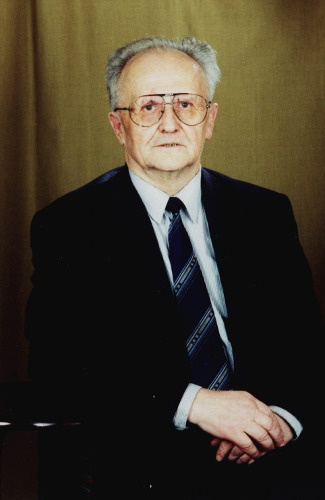 Roman L. Sorochenko (Photo courtesy of Moscow State University)
Roman L. Sorochenko (Photo courtesy of Moscow State University)
Roman L. Sorochenko
Contributed by Sergei Gulyaev
Roman L. Sorochenko (1924-2017), one of the pioneers of radio astronomy, participated in the design and construction of the first radio telescopes, the discovery of radio recombination lines and the creation of a new field in radio astronomy - radio spectroscopy.
In 1942 after graduation from high school at the age of 18, he went to the German-Russian front of WW2 as an ordinary infantry soldier. He was decorated with one order and several medals. In 1947 he entered the Moscow State University Faculty of Physics and Technology (later Moscow Institute of Physics and Technology - Phys-Tech), and graduated with the equivalent of a master degree in 1952. At that time, his teachers were Axel Berg, Lev Landau, Pyotr Kapiza, and others. While a student, he started working in FIAN (the P. N. Lebedev Physical Institute) in the Oscillations Laboratory headed by Alexander Prokhorov. His research in radio astronomy was initially connected with the development of the first (in the USSR) reflector radio telescope (7.5-m diameter, 1949). Later, he participated in the construction of the 22-m radio telescope in Pushchino, the development of quantum parametric amplifiers (masers) for radio astronomy (joint paper with Martirosian and Prokhorov), including the development of a 36.5 GHz maser amplifier for the Pushchino 22-m radio telescope, which allowed him (jointly with Borodzich) to discover radio recombination lines in 1964.
Since 1964, his work concentrated primarily on the detection of radio recombination lines and studying giant (Rydberg) atoms in space. Sorochenko's contribution in this field was vast. It includes the first detection of radio recombination lines, observations of RRLs over an enormous range of wavelengths -- from 8 mm to 10 m, solving the problem of the compensation of Stark broadening (with Minaeva and Sobel'man), the prediction of inhomogeneity/clumps in HII regions (with Pikel'ner and Gulyaev), pioneering observations of high-order RRLs (with Smirnov and Pankonin), estimation of primordial Helium abundance (with Ztivilev et al.), of the rate of ionisation of the interstellar hydrogen by cosmic rays (with Smirnov), and others. His monograph Radio Recombination Lines (with M. Gordon) discussed more than a thousand publications and is widely considered to be one of the most comprehensive reviews of radio recombination lines.
Modified on Monday, 14-Feb-2022 12:24:04 EST by Ellen Bouton, Archivist (Questions or feedback)
|
![[IAU logo]](iau_wb_thumb.jpg)
![[URSI logo]](URSI-logo-thumb.jpg)
![[Karl Jansky at his antenna]](jansky_photo_02_thumb.jpg)
![[Reber's Wheaton antenna]](Reber_Telescope_Wheaton_thumb.jpg)
![[Dover Heights]](Dover_Heights_02_thumb.jpg)
![[4C telescope]](GB61-195_4C_telescope_thumb.jpg)
![[Ewen and horn antenna]](ewen_horn1s.jpg)
![[Dwingeloo, 1956]](Dwingeloo-1956-thumb.jpg)
![[Jocelyn Bell Burnell and Cambridge antenna used in pulsar discovery]](burnell2_thumb.jpg)
![[Lovell Telescope at Jodrell Bank]](site_1594_0001-500-334-20180316163019-thumb150.jpg)
![[Wilson, Penzias, and Bell Labs horn antenna]](wilson-penzias-horn_thumb.jpg)
![[6-m Millimeter Radio Telescope in Mitaka, Japan]](6m-thumb.jpg)

